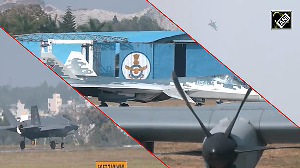India will join the United States, Russia, China, Japan, the European Union and Korea in a 4.6 billion euro ($5.4 billion or Rs 25,000 crore) experimental fusion reactor project, it was revealed on Wednesday.
If you are wondering just what that means, read on:
What is ITER?
It stands for the International Thermonuclear Experimental Reactor, which is supposed to harness fusion energy to produce energy for civilian purposes. Fusion is the process of fusing two small nuclei to form a bigger nucleus. It is the process by which the sun radiates energy and by which hydrogen bombs work. In the sun, hydrogen atoms fuse to form helium, emitting vast amounts of nuclear energy.
Fusion is the opposite of fission, which is the principle by which atom bombs work by splitting a heavy nucleus into two smaller nuclei.
But ITER -- pronounced like 'fitter' without the 'f' -- is all about making the energy released in the fusion process work for mankind, not against it.
Incidentally, ITER means 'the way' in Latin. Experts believe with fossil fuel reserves fast depleting, nuclear energy is the way to meet mankind's ever-increasing energy needs.
Why nuclear fusion?
Because fuel required for fusion is abundant and inexhaustible, the fusion process is considered safe, and fusion plants do not damage the environment.
So why haven't countries taken to fusion energy in a big way?
Since the 1950s, scientists all over the world have been trying to harness fusion energy for peaceful uses. But, so far, the fusion machines have been able to produce only small amounts of energy. ITER plans to change that.
Where and when will ITER be built?
ITER is being constructed in southern France at Cadarache, near the Aix-en-Provence. It should be operational by 2016.
How much energy are we talking about here?
As mentioned before, fusion powers the sun and the stars. So, theoretically, fusion can yield huge amounts of energy. But ITER is aiming at producing 500 MW of energy.
When was ITER planned?
Plans for ITER began in 1985. After many rounds of negotiations and planning -- which are unavoidable for a project that involves so many countries -- the work on the design of the reactor started on in 2001. Even as you read this, ITER's design is being finetuned in Naka, near Tokyo, Japan, and in Garching, near Munich, Germany. Teams of scientists from the participating countries are also working on it.
Why was India included?
As Dr V P Raja, head of the Indian delegation in Jeju, Republic of Korea, said: "Our scientists have already designed and fabricated two tokamak devices [a kind of nuclear reactor, the ITER will also be a tokamak device] Aditya and the steady state superconducting tokamak SST 1. Many technologies of relevance to the forefront of fusion research have been developed by our scientists and engineers in collaboration with our industries. We thus bring to the table a combination of strong commitment from the government and special scientific and technological skills, which are of relevance to ITER and to fusion research."
The whisper in official circles is also that India's inclusion into the ITER project is a result of the India-US nuclear agreement of July 18.






 © 2025
© 2025